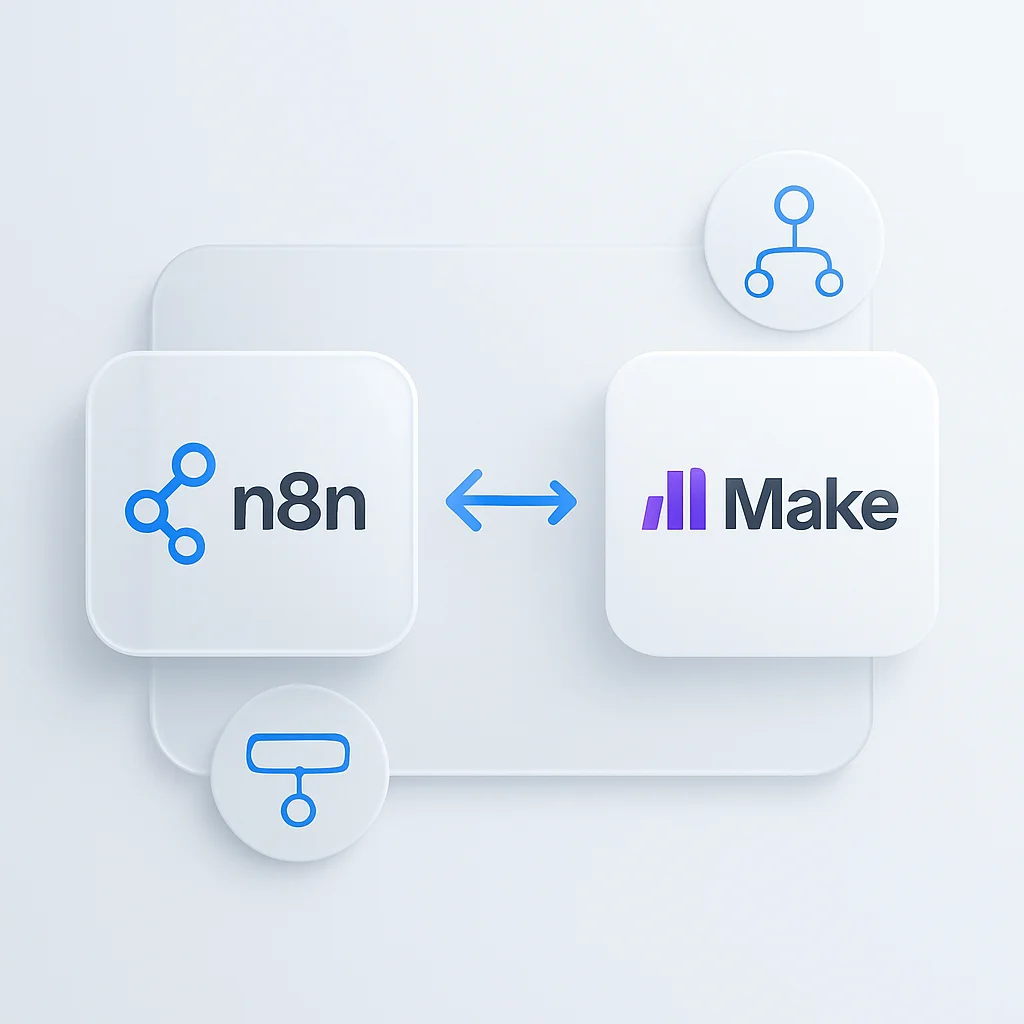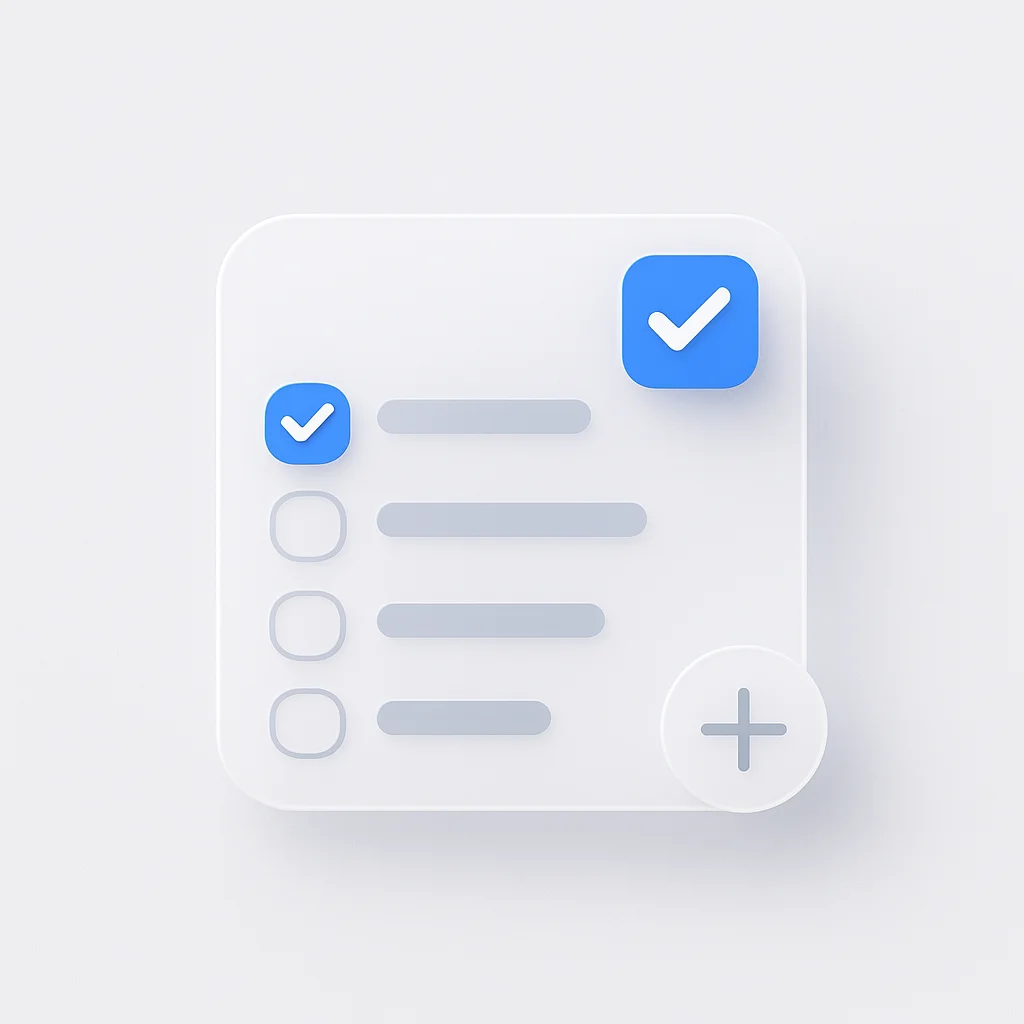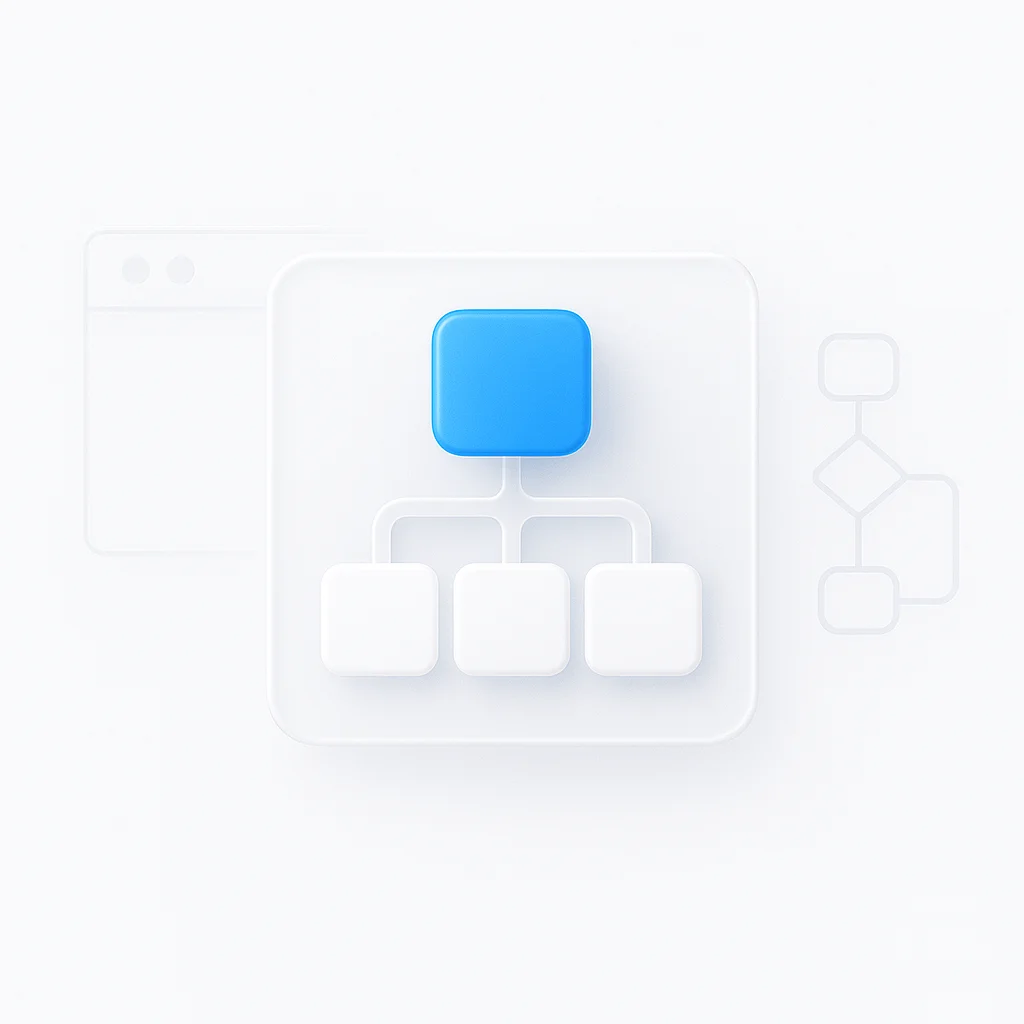In the world of automation, two powerful contenders stand out: the flexible, open-source power of n8n and the polished, user-friendly experience of Make. Choosing the right one is a critical decision that will define your automation capabilities and determine how efficiently your business processes run.
🎯 What You'll Discover in This Comparison
This is your definitive, unbiased comparison. We’ll dive deep into every crucial aspect from pricing plans and core features to the debate on self-hosting vs cloud to help you confidently decide if n8n or Make is the right workflow automation tool for you in 2025.
At a Glance: n8n vs Make Quick Comparison
Understanding the difference between these automation powerhouses starts with their core philosophies. Here’s what you need to know immediately:
| Feature | n8n | Make (formerly Integromat) |
|---|---|---|
| Core Model | Open-Source, "Fair-Code" | Proprietary, Cloud-Based (SaaS) |
| Best For | Developers, Tech-Savvy Users, Self-Hosters | Marketers, No-Code Beginners, Small Businesses |
| Key Strength | Unmatched Flexibility - Customization | Extreme Ease of Use - Massive App Library |
| Pricing | Generous Free Tiers, Lower Cloud Costs | Operations-Based, Can Get Expensive at Scale |
| Learning Curve | Moderate to High | Low to Moderate |
The Core Philosophy: Freedom vs Simplicity
The fundamental difference between n8n and Make lies in their core philosophies. Understanding this distinction will help you make the right choice for your organization. To further enhance your workflow, you can use our Workflow Connect to integrate your meeting data with your favorite tools. Our Decision Tracker can help you keep track of all the decisions made in your meetings, and our Team Flow can help you boost your team’s productivity.

n8n: The Freedom of Open-Source and Self-Hosting
n8n represents the ultimate in workflow automation flexibility. As an open-source platform with a “fair-code” license, it offers complete data control, enhanced privacy, and freedom from vendor lock-in. You can run n8n on your own hardware even a Raspberry Pi giving you unprecedented control over your automation infrastructure.
The n8n GitHub community is vibrant and active, with developers constantly contributing new nodes and features. This means you’re not limited to pre-built integrations; you can create custom connections and modify the platform to meet your exact needs.
Key advantages of n8n’s approach:
- Complete data sovereignty and privacy
- No operational limits on the self-hosted version
- Ability to create custom nodes and integrations
- Version control for your workflows
- No vendor lock-in concerns
Make: The Convenience of a Polished Cloud Platform
Make takes a different approach, focusing on delivering a seamless, fully managed SaaS experience. As an iPaaS (Integration Platform as a Service), Make handles all the infrastructure, maintenance, and updates, allowing you to focus entirely on building and running your automations.
The platform excels in no-code development, making sophisticated workflow automation accessible to marketers, business owners, and non-technical users. According to Gartner’s 2024 integration platform research, cloud-native iPaaS solutions like Make are seeing 40% year-over-year growth due to their accessibility and reduced operational overhead.
Key advantages of Make’s approach:
- Zero server management or maintenance
- Instant setup and deployment
- Guaranteed uptime and professional support
- Massive library of pre-built app integrations
- Regular updates and new features without user intervention
Feature Deep Dive: A Head-to-Head Battle
Let’s examine how these platforms compare across critical functionality areas.
The Visual Workflow Builder: User Experience Compared
🎨 n8n's Node-Based Interface
n8n uses a node-based visual editor where each step in your workflow is represented as a connected node. This approach provides incredible flexibility for complex logic, conditional branches, and data transformation. However, it requires more technical understanding to master effectively.
📋 Make's Scenario Builder
Make's visual "scenario" builder uses a more linear, step-by-step approach that feels intuitive to non-technical users. The interface is polished and user-friendly, with helpful tooltips and guided setup processes that make workflow creation accessible to anyone.
Integrations - Nodes: Who Connects to More Apps?
Both platforms offer extensive integration libraries, but with different strengths:
Make’s Integration Advantage:
- Over 1,500 pre-built app integrations
- Extensive support for popular business tools (Salesforce, HubSpot, Slack, etc.)
- Regular addition of new connectors based on user demand
- Detailed documentation for each integration
n8n’s Custom Integration Power:
- 400+ pre-built nodes with active community contributions
- Powerful HTTP request node for connecting to any API
- Ability to create custom nodes using JavaScript
- Community-driven expansion through the GitHub repository
For businesses using standard SaaS applications, Make’s extensive integration library provides immediate value. For organizations with custom APIs or unique requirements, n8n’s flexibility in creating custom connections is unmatched.
Error Handling - Advanced Logic
Both platforms handle errors differently, reflecting their target audiences:
n8n’s Developer-Friendly Approach:
- Detailed error logs and debugging information
- Built-in retry logic with customizable parameters
- Version control integration for workflow management
- Advanced conditional logic and data transformation capabilities
Make’s User-Friendly Error Management:
- Visual error indicators in the scenario builder
- Automated retry options with simple configuration
- Error handling wizards that guide users through setup
- Email notifications for failed scenarios

n8n vs Make: A Clear Breakdown of Pricing Plans
Pricing is often the deciding factor between these platforms. Let’s break down what you actually pay for each option in 2025.
💰 Pricing Reality Check
The "operations" model vs execution limits can dramatically affect your costs
n8n Pricing Plans (2025)
Self-Hosted
- Unlimited workflows - executions
- All core features
- Complete data control
- Community support
Cloud Starter
- 2,500 executions/month
- Managed hosting
- Email support
- 99.9% uptime SLA
Cloud Pro
- 10,000 executions/month
- Advanced logging
- Priority support
- Environment variables
Make.com Pricing Plans (2025)
Make uses an “operations” based pricing model, where each action in your workflow counts as one operation. This can become expensive for high-volume automations.
Limited Starter
- 1,000 operations/month
- 2 active scenarios
- Basic integrations
- Community support
Core
- 10,000 operations/month
- Unlimited scenarios
- Standard integrations
- Email support
Pro
- 40,000 operations/month
- Priority support
- Advanced analytics
- Custom apps - webhooks
Teams
- 100,000 operations/month
- Team collaboration
- Advanced features
- Priority support
The Verdict on Value: Which is More Cost-Effective?
- For low-volume, complex workflows: n8n's self-hosted plan is unbeatable (free)
- For high-volume, simple automations: Make's entry-level plans are very accessible
- For enterprise needs: n8n cloud pricing scales more predictably than Make's operations model
According to Forrester’s automation platform research, organizations save an average of 40% on automation costs when choosing platforms with predictable pricing models over operation-based billing.
Use Cases - Target Audience: Which Tool is Built for You?
The choice between n8n and Make often comes down to your technical comfort level and specific use case requirements.
🛠️ Choose n8n if...
⚡ Choose Make if...
Real-World Use Case Examples
Perfect n8n Scenarios:
- Custom CRM integration with proprietary business systems
- Complex data processing pipelines with multiple transformation steps
- Compliance-heavy industries requiring data sovereignty
- Cost-sensitive operations with high automation volumes
Perfect Make Scenarios:
- Marketing automation connecting Mailchimp, Google Sheets, and Slack
- E-commerce order processing across multiple platforms
- Social media management workflows
- Quick prototyping of business process automation
For content creators managing video workflows, tools like AI video summarizers can integrate seamlessly into both platforms, though the setup complexity will vary significantly between n8n and Make.
Essential Considerations: Integration with Modern Tools
Both platforms excel at connecting various business tools, but their approaches differ significantly when handling modern productivity workflows.
API Integration Capabilities
n8n’s HTTP Request Node Advantage: The platform’s flexible HTTP request node allows you to connect with virtually any API, making it ideal for organizations with custom software or unique integration requirements. You can build sophisticated error handling, custom authentication flows, and complex data transformation directly within the workflow.
Make’s Pre-Built Integration Strength: With over 1,500 pre-configured integrations, Make excels when your needs align with popular business applications. Each integration comes with detailed documentation, field mapping assistance, and built-in error handling specific to that service.
For teams working with meeting recordings and transcription, both platforms can automate the flow from recording to processed content, though the implementation complexity varies considerably.
Expanded FAQ: Your Top Questions Answered
Is n8n really free?
Yes, n8n is completely free when self-hosted. You get unlimited workflows, executions, and access to all features without any operational limits. The only costs are your hosting infrastructure and maintenance time. This makes it particularly attractive for startups and organizations with technical resources.
Is Make easier to use than n8n for a beginner?
Absolutely. Make is specifically designed for non-technical users with its intuitive scenario builder, guided setup processes, and extensive documentation. Most users can create their first automation within 30 minutes. n8n requires more technical understanding but offers greater flexibility for complex requirements.
How does n8n and Make compare to Zapier?
Both n8n and Make offer more advanced features than Zapier at competitive prices. n8n provides superior customization and cost-effectiveness for technical users, while Make offers a more user-friendly interface than Zapier with better pricing for high-volume usage. For a detailed comparison, check out our analysis of workflow automation alternatives.
Can n8n handle enterprise-level workflows?
Yes, n8n is designed to scale with advanced features like version control, environment variables, queue management, and robust error handling. Many enterprises choose n8n for its self-hosting capabilities, which provide complete control over data and compliance requirements.
What are the main limitations of Make’s free plan?
Make’s free plan includes 1,000 operations per month and limits you to 2 active scenarios. For context, checking Gmail and updating a spreadsheet counts as 2 operations. Most business users exceed this limit quickly, making the Core plan ($9/month) more practical for ongoing use.
How do I get started with workflow automation?
Start by identifying repetitive tasks in your current processes. Document the steps, data flows, and decision points. For beginners, Make’s free plan offers an excellent way to experiment. For technical teams, n8n’s self-hosted option provides unlimited experimentation. Consider exploring business process automation best practices before choosing your platform.
The Final Verdict: Making Your Decision
After comparing features, pricing, and use cases, the choice between n8n and Make comes down to your organization’s priorities and technical capabilities.
🎯 Decision Framework Summary
Choose n8n if you value ultimate control and customization, have technical resources available, or need to maintain strict data privacy through self-hosting. The platform’s flexibility and cost-effectiveness make it ideal for organizations willing to invest time in setup for long-term benefits.
Choose Make if you prioritize speed of implementation, ease of use, and comprehensive app support over customization options. Its managed service approach and user-friendly interface make it perfect for teams that want to focus on business processes rather than technical infrastructure.
Remember: Both platforms offer free plans that let you experiment before committing. Consider starting with the platform that aligns with your team’s technical comfort level, then scale your automation strategy as your needs evolve.
The workflow automation landscape continues evolving rapidly. Whether you choose the flexible power of n8n or the accessible efficiency of Make, you’re investing in technology that will streamline your operations and free your team to focus on higher-value activities.



